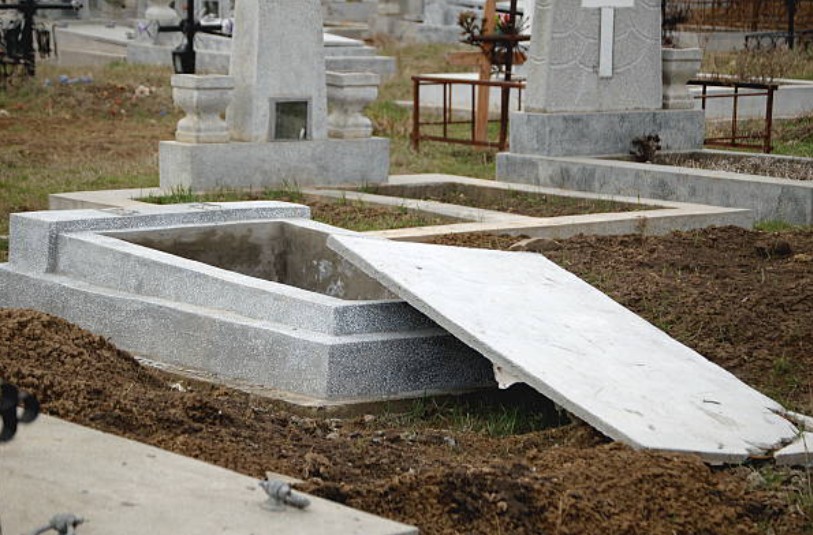The Resurrection in Matthew 27

“Jesus cried out again with a loud voice, and yielded up His spirit. Then behold, the veil of the temple was torn in two from top to bottom; and the earth quaked, and the rocks were split, and the graves were opened; and many bodies of the saints who had fallen asleep were raised; and coming out of the graves after His resurrection, they went into the holy city and appeared to many” (Matt. 27:51–53)
Was this a physical resurrection…or was there something else going on here? I think the biblical evidence shows it’s the latter. This was likely a vision of a soon-coming general resurrection.
Notice how Matthew says these saints “appeared”[1] to many people. Now compare this to how Matthew described the transfiguration a few chapters earlier:
“[Jesus] was transfigured before them. His face shone like the sun, and His clothes became as white as the light. And behold, Moses and Elijah appeared[2] to them, talking with Him” (Matt. 17:2-3).
At the transfiguration, Moses and Elijah “appeared” to Jesus and his disciples. They even spoke to them. Yet a few verses later, Jesus called this appearance a vision: “Now as they came down from the mountain, Jesus commanded them, saying, ‘Tell the vision to no one until the Son of Man is risen from the dead’” (Matt. 17:9). So this “appearance” was a vision.
And this is likely what the resurrection “appearance” in Matthew 27 was too—a vision.
The transfiguration “appearance”/vision in Matthew 17 testified to the soon-coming better new covenant. Similarly, the resurrection “appearance”/vision in Matthew 27 testified to the soon-coming general resurrection. It was a sign that Jesus was in fact the resurrection and the life, and that he was restoring mankind’s broken relationship with God (because of sin). The risen saints showed the Jewish leadership in the “holy city” Jerusalem that Jesus was in fact fulfilling the resurrection expectations of Israel which had been prophesied about all through the Old Testament (see Hos. 6:2, Dan. 12:2, Isa. 25:8).
Something similar had happened prior to Jesus’ death, too. Just before Jesus raised his friend Lazarus from the dead, Jesus said, “I am the resurrection and the life. He who believes in Me, though he may die, he shall live. And whoever lives and believes in Me shall never die” (John 11:25–26). Then Jesus asked Lazarus’ sister, Martha, “Do you believe this?” (v. 26).
Then, just before raising Lazarus, Jesus said he was doing this so that the people of his day would believe that he really was who he claimed to be (v. 42). Anyone can claim to be the resurrection and the life, but Jesus proved it by raising Lazarus from the dead. This was a sign—or proof—that Jesus was overcoming (spiritual) death and restoring mankind’s broken relationship with God. In fact, the Pharisees even called this event a sign: “What shall we do? For this Man works many signs” (v. 47). Signs point to greater realities, and that’s what this event was, a sign pointing to the greater general resurrection.
Jesus called his own resurrection a sign, too. In one of his conversations with the Pharisees, the Pharisees had asked:
“‘Teacher, we want to see a sign from You.’ But He answered and said to them, ‘An evil and adulterous generation seeks after a sign, and no sign will be given to it except the sign of the prophet Jonah. For as Jonah was three days and three nights in the belly of the great fish, so will the Son of Man be three days and three nights in the heart of the earth’” (Matt. 12:38–40).
Jesus called his resurrection a sign. It was a sign—or proof—that Jesus had overcome (spiritual) death and was in fact restoring man’s broken relationship with God. This is what the general resurrection was all about!
And this is what the vision of the risen saints walking around Jerusalem was too (in Matthew 27))—a sign. It was a sign that testified to the Jewish establishment of that day that Jesus was exactly who he claimed to be, the resurrection and the life.
For more information about the topics discussed in this article, get my book The End Is Here: How the New Testament’s Prophecies Were Fulfilled.
By Alex Polyak, Director of The Bible Fulfilled, 2/7/25
[1] Strong’s Lexicon #1718: Emphanizó – to make manifest, to reveal, to show, to declare
[2] Strong’s Lexicon #3708: Horaó – to see, perceive, attend tond to
